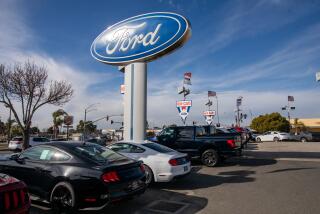For those considering a lease, the good and bad of owning nothing
- Share via
For anyone shopping on a tight budget, an ad that promises a new-car lease for $500 down and $199 a month sounds tempting.
Few new cars are cheap enough to buy under those terms, even with zero-percent financing.
Two advantages that leasing has over buying are that most leases require a smaller down payment, and the monthly payments usually are lower than on a loan for a comparably priced purchased vehicle.
In the long run, however, leasing may be no cheaper. Edmunds.com, an automotive information site, compared the cost of buying versus leasing a $20,000 car, and over five years buying turned out to be $248 cheaper, a difference of about $4 a month.
The main difference is that a lease is a long-term rental agreement, usually three or four years. At the end of the lease, the consumer has no equity in the vehicle and can return it to the leasing company or buy the vehicle.
By contrast, after paying off a loan an owner can sell the vehicle, use it as a down payment on a new one or keep driving it until it falls apart.
The Consumer Bankers Assn. said 82% of new-vehicle loans are for longer than 48 months. That means the monthly payments often last longer than the new-vehicle warranty, so the owner may be saddled with expensive repairs before the car is paid off.
With leasing, the vehicle will be under warranty for all or most of the lease term, freeing the user from budget-breaking repair costs. And with leasing there’s no long-term commitment. Once the lease runs its course, both parties can move on.
Nearly three of four consumers buy instead of lease, but ownership carries risks too.
Resale value can drop dramatically as market conditions change. For example, truck-based sport utility vehicles such as the Ford Explorer and Chevrolet TrailBlazer are popular today but may not be five years from now if the price of gasoline rises to $3 a gallon. If that happens, the resale value of SUVs probably would plummet, and owners of Explorers and similar models would bear the burden.
In a lease, the leasing company sets the resale (or residual) value at the start of the contract. At the end of the lease, even if the vehicle is worthless, the consumer can walk away without further financial obligation. The cost is borne by the lessor.
The Assn. of Consumer Vehicle Lessors, an organization that promotes leasing on behalf of banks and the finance units of auto companies, advises that anyone who commits to a lease should plan on finishing it. Bailing out early usually triggers a substantial fee.
Rob Gentile, manager of the auto price service for Consumer Reports magazine, said leasing has advantages, but he urges people to look beyond the $199-a-month teasers in the ads. Chances are they don’t include the typical upfront costs of a lease, such as the acquisition fee or security deposit.
“You need to factor in all of your costs,” Gentile said. “The upfront costs may be a couple of thousand dollars out of your pocket.”
Nor do ads include sales tax, which varies by city and county.
In most states, sales tax on leased vehicles applies only to the monthly payments.
Gentile also warns that leasing carries more responsibilities than might be obvious.
Mileage is one area of concern. The standard mileage allowance on leases used to be 12,000 miles a year, but some manufacturers have cut back to 10,000. (Keep in mind that the average driver covers 15,000 miles a year.)
Exceeding the limit costs 15 cents or more per mile. Those who think they will exceed the mileage limit can purchase additional miles at a lower price at the start of a lease.
There’s also the possibility of end-of-lease charges for “excessive wear and tear,” Gentile said. Leasing companies inspect vehicles at the end of the term, and what a consumer considers “reasonable” wear may be “excessive” to the lessor.
Excess-wear charges can add hundreds of dollars to end-of-lease charges, he said.
Ownership means there are no mileage limits or outside parties monitoring wear and tear. There still is a price to pay for high mileage and a trashed interior, which reduce resale value and make a car less desirable.
Consumers can purchase their vehicle at the end of a lease, but Gentile said whether that is a good deal depends on the purchase price in the contract. “What can you buy it for? Sometimes the residual value set at the start of the lease is too high,” he said. “You may end up paying more than it’s worth.”
Another option at the end of a lease is to lease another vehicle, but Gentile said that may lock consumers into “the perpetual monthly payment, and you never really own anything.”






